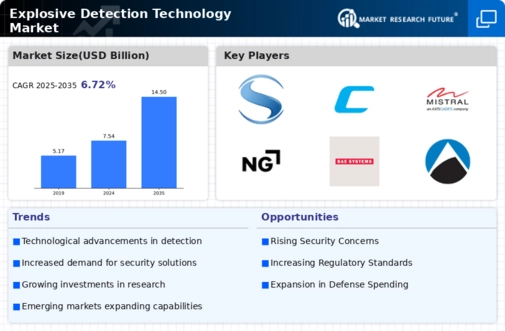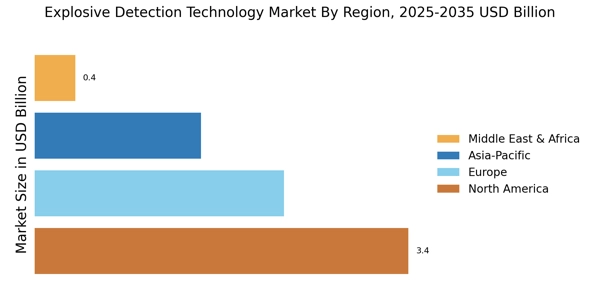Emergence of Smart Cities
The concept of smart cities is gaining traction, leading to an increased focus on integrated security solutions, including explosive detection technologies. As urban areas evolve into smart cities, the need for comprehensive security systems that can monitor and respond to threats in real-time becomes critical. The Explosive Detection Technology Market is poised to benefit from this trend, as municipalities invest in smart surveillance and detection systems. By 2025, the market is projected to grow by 7% annually, driven by the integration of IoT and AI technologies in urban security frameworks. This shift towards smart city initiatives is likely to create new opportunities for innovative explosive detection solutions.
Technological Advancements
The rapid evolution of technology plays a crucial role in shaping the Explosive Detection Technology Market. Innovations in sensor technology, data analytics, and artificial intelligence are enhancing the accuracy and efficiency of explosive detection systems. For instance, the integration of machine learning algorithms allows for real-time analysis of data, significantly improving threat detection capabilities. As of 2025, the market is expected to witness a compound annual growth rate of around 8%, reflecting the impact of these advancements. Furthermore, the development of miniaturized detection devices is making it feasible to deploy explosive detection solutions in a wider array of environments, from airports to public events.
Increasing Security Concerns
The rising frequency of terrorist activities and violent crimes has heightened the demand for advanced security measures. This trend is particularly evident in urban areas and critical infrastructure, where the need for effective explosive detection solutions is paramount. The Explosive Detection Technology Market is experiencing growth as governments and private sectors invest in sophisticated detection systems to mitigate risks. In 2025, the market is projected to reach a valuation of approximately USD 6 billion, driven by the necessity for enhanced safety protocols. This increasing focus on security is likely to propel innovations in detection technologies, ensuring that they meet the evolving threats posed by explosives.
Government Initiatives and Funding
Government initiatives aimed at bolstering national security are significantly influencing the Explosive Detection Technology Market. Various countries are allocating substantial budgets to enhance their security infrastructure, which includes the procurement of advanced explosive detection systems. In 2025, it is anticipated that government spending on security technologies will exceed USD 10 billion, with a considerable portion directed towards explosive detection solutions. This funding not only supports the development of new technologies but also encourages public-private partnerships, fostering innovation and improving the overall effectiveness of detection systems. Such initiatives are likely to create a robust market environment for explosive detection technologies.
Growing Demand in Transportation Sector
The transportation sector is witnessing an increasing demand for explosive detection technologies, particularly in aviation and railways. With the rise in passenger traffic and the potential threats associated with it, transportation authorities are prioritizing the implementation of advanced detection systems. The Explosive Detection Technology Market is expected to benefit from this trend, as investments in airport security and railway safety are projected to reach USD 4 billion by 2025. Enhanced screening processes and the deployment of state-of-the-art detection equipment are becoming standard practices, ensuring the safety of travelers and cargo alike. This growing emphasis on security within the transportation sector is likely to drive market expansion.


















Leave a Comment